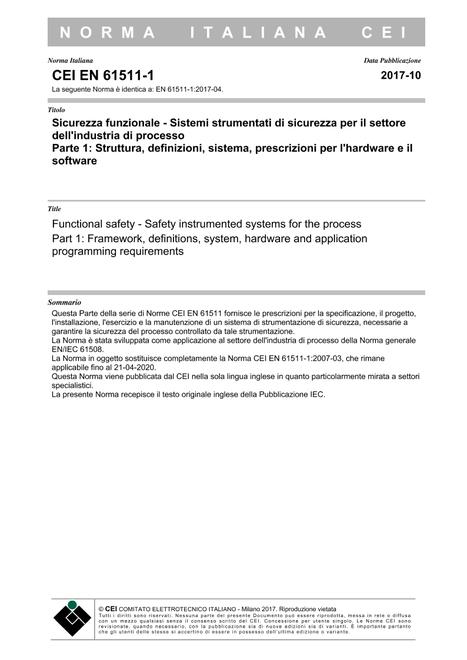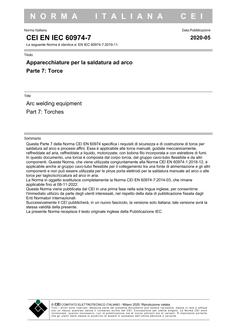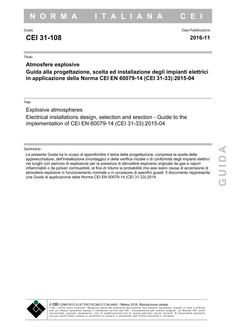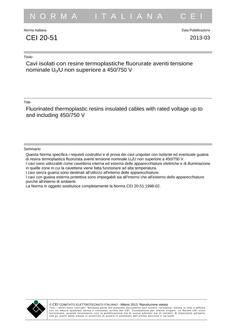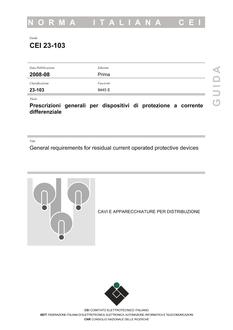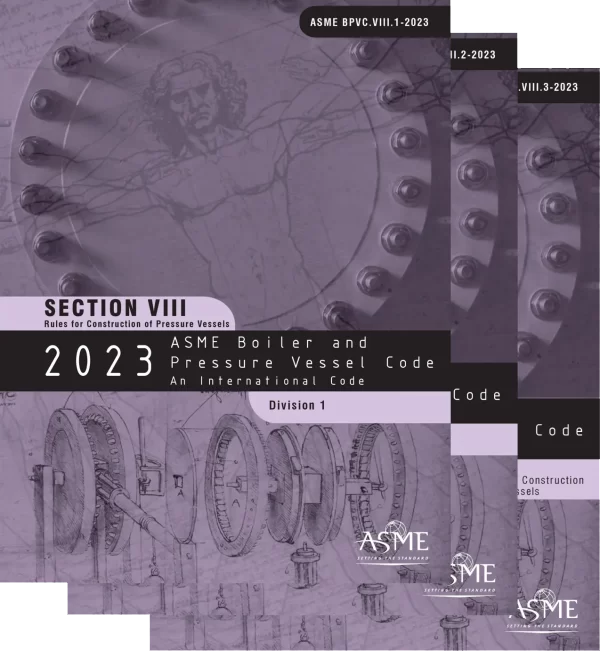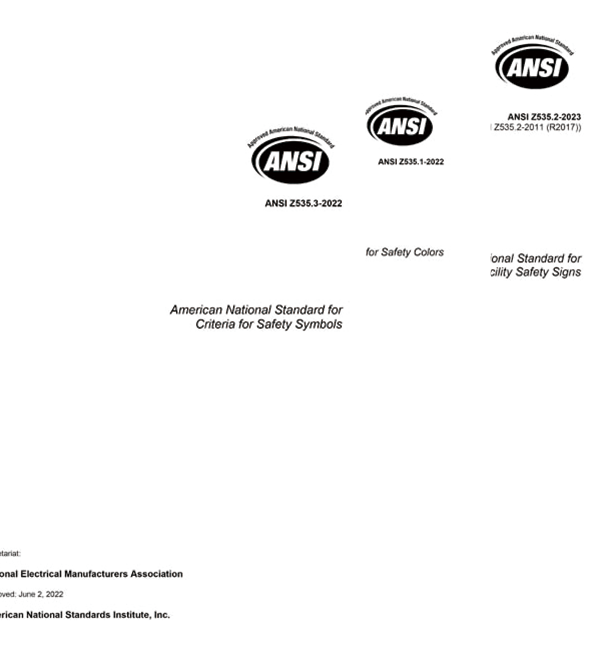CEI EN 61511-1
2017
Functional safety – Safety instrumented systems for the process Part 1: Framework, definitions, system, hardware and application programming requirements
- Format:
- Language(s) :
- Published :
- English
- 10/01/2017
This part of IEC 61511 gives requirements for the specification, design, installation, operation and maintenance of a safety instrumented system (SIS), so that it can be confidently entrusted to achieve or maintain a safe state of the process. IEC 61511-1 has been developed as a process sector implementation of IEC 61508:2010.
In particular, IEC 61511-1:
a) specifies the requirements for achieving functional safety but does not specify who is responsible for implementing the requirements (e.g., designers, suppliers, owner/operating company, contractor). This responsibility will be assigned to different parties according to safety planning, project planning and management, and national regulations;
b) applies when devices that meets the requirements of the IEC 61508 series published in 2010, or IEC 61511-1:2016 [11.5], is integrated into an overall system that is to be used for a process sector application. It does not apply to manufacturers wishing to claim that devices are suitable for use in SISs for the process sector (see IEC 61508-2:2010 and IEC 61508-3:2010);
c) defines the relationship between IEC 61511 and IEC 61508 (see Figures 2 and 3);
d) applies when application programs are developed for systems having limited variability language or when using fixed programming language devices, but does not apply to manufacturers, SIS designers, integrators and users that develop embedded software (system software) or use full variability languages (see IEC 61508-3:2010);
e) applies to a wide variety of industries within the process sector for example, chemicals, oil and gas, pulp and paper, pharmaceuticals, food and beverage, and non-nuclear power generation;
NOTE 1 Within the process sector some applications may have additional requirements that have to be satisfied.
f) outlines the relationship between SIFs and other instrumented functions (see Figure 4);
g) results in the identification of the functional requirements and safety integrity requirements for the SIF taking into account the risk reduction achieved by other methods;
h) specifies life-cycle requirements for system architecture and hardware configuration, application programming, and system integration;
i) specifies requirements for application programming for users and integrators of SISs.
j) applies when functional safety is achieved using one or more SIFs for the protection of personnel, protection of the general public or protection of the environment;
k) may be applied in non-safety applications for example asset protection;
l) defines requirements for implementing SIFs as a part of the overall arrangements for achieving functional safety;
m) uses a SIS safety life-cycle (see Figure 7) and defines a list of activities which are necessary to determine the functional requirements and the safety integrity requirements for the SIS;
n) specifies that a H&RA is to be carried out to define the safety functional requirements and safety integrity levels (SIL) of each SIF;
NOTE 2 Figure 9 presents an overview of risk reduction means.
o) establishes numerical targets for average probability of failure on demand (in demand mode) and average frequency of dangerous failures (in demand mode or continuous mode) for each SIL;
p) specifies minimum requirements for hardware fault tolerance (HFT);
q) specifies measures and techniques required for achieving the specified SIL;
r) defines a maximum level of functional safety performance (SIL 4) which can be achieved for a SIF implemented according to IEC 61511-1;
s) defines a minimum level of functional safety performance (SIL 1) below which IEC 61511-1 does not apply;
t) provides a framework for establishing the SIL but does not specify the SIL required for specific applications (which should be established based on knowledge of the particular application and on the overall targeted risk reduction);
u) specifies requirements for all parts of the SIS from sensor to final element(s);
v) defines the information that is needed during the SIS safety life-cycle;
w) specifies that the design of the SIS takes into account human factors;
x) does not place any direct requirements on the individual operator or maintenance person:
NOTE 3 IEC 61508 is also used by safety instrumented designers, integrators and users where directed in IEC 61511.
| CEI EN 61511-1 | |
|---|---|
| STANDARD INFO: | |
| Standard Name | CEI EN 61511-1 |
| Scope | Functional safety - Safety instrumented systems for the process Part 1: Framework, definitions, system, hardware and application programming requirements |
| Publisher | CEI - Comitato Elettrotecnico Italiano |
| Languages | English |
| State | [ Active ] |
| Publication Year | 2017 |
| Most recent Version | MOST RECENT |
| Whether to be replaced | |
| Addendum | |
| FILE INFO: | |
| Edition | 17 |
| File Size | 1 file , 1.8 MB |
| Number of Pages | 90 |
| Published | 10/01/2017 |
| CEI EN 61511-1 | ||
|---|---|---|
| History | Publisher Year | |
| CEI EN 61511-1 | 2017 | Current |
| CEI EN 61511-1 | 2007 |
Related products
- Format:
- Language(s) :
- Published :
- English
- 05/01/2020
$39
- Format:
- Language(s) :
- Published :
- Italian
- 11/01/2016
$97
- Format:
- Language(s) :
- Published :
- Italian
- 03/01/2013
$14
- Format:
- Language(s) :
- Published :
- English
- 08/01/2008
$66

Over 3,000,000 global standards
Our standards library is extensive, with over 2 million documents, ensuring we meet the needs of various industries. Whether it’s ASME, DIN, ASTM or ISO and other internationally recognized standards, we offer complete documents and the latest versions to help customers adhere to industry regulations in their projects. Whether your needs are technical standards, regulatory requirements, or design guidelines, our standards library provides comprehensive support.
24 online customer service
Our team includes up to 50 engineers from fields such as healthcare, electronics, and construction, who can answer your technical questions and ensure you find the correct and accurate standard documents. We are dedicated to helping you find the best solution that meets your needs.

Thanks to the StandardsClub customer service team for helping me find the ASME BPVC-2023 SET I was looking for in a high-quality PDF version. Their assistance was excellent, and the document quality exceeded my expectations!
This standard document is very detailed, covering all relevant technical points, and provides comprehensive guidance for my project. The ANSI/NEMA Z535 SET was exactly what I needed, and I am very satisfied with the quality!
The purchasing process was straightforward, the price was very competitive, and the download was quick. The Tissue Engineering Standards Addressing Product Quality and Characterization Package was of excellent quality and provided all the information I needed. Definitely a great value for the price!
“Got questions? Our professional customer service is ready to assist you anytime. Whether it’s finding documents, getting discounts, or navigating the purchase process, let us help you get the standards you need!”

Sign Up Our Newsletter
Don’t miss out! Subscribe now to get exclusive offers and industry insights!
We care about your data in ou privacy policy.

